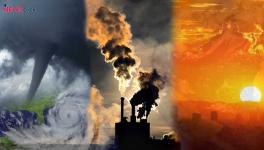James Webb Telescope Finds Planet-forming Ingredients in Galaxy Near Milky Way
Representational use only.Image Courtesy: Medium.Com
We live on planet Earth, which is part of the solar system, and the solar system belongs to the Milky Way. The Milky Way is our galaxy. Countless galaxies in the universe have stunned scientists from time immemorial. A galaxy consists of stars and planets, the interstellar medium (the space between star systems in a galaxy consisting of dust, radiation, etc.), and nebulae (the luminescent and active star-forming regions of a galaxy).
How stars and planets in a galaxy form, and what the characteristics of ancient galaxies in the sky are, are intriguing questions that scientists have been attempting to answer since ancient times. Incessant efforts have been made to obtain these answers, and scientists now believe that they have been able to decipher some of them.
With the help of the James Webb Space Telescope (JWST) launched in December 2021, scientists have discovered elements of planet formation in a galaxy near our own Milky Way where it was previously thought that planets may not form. The discovery has been published recently in Nature Astronomy. What the powerful JWST has deciphered is an indication that planet formation may be a common phenomenon throughout the universe.
Researchers focused on the NGC 346, which is an active star-forming region in the galaxy called Small Magellanic Cloud (SMC), near the milky way. NGC 346 has been an object of interest for astro scientists because of its lower concentration of metals. It should be noted that astronomers’ definition of metal is an element which is heavier than hydrogen or helium. The low metal concentration at NGC 346 is also significant from another perspective, pertaining to the ‘Cosmic noon’.
Cosmic noon signifies a time period after the Big Bang when the universe emerged. Nearly 10 billion years ago, during cosmic noon, stars were formed in abundance in almost all the galaxies of the universe. In other words, cosmic noon is the period of star formation. Notably, low-mass stars of the galaxies outnumber the high-mass stars. Our star Sun is also a low-mass one. So, understanding the formation of a low-mass star anywhere in the galaxies can help scientists understand the formation of our solar system. Moreover, NGC 346 is bigger than any other star-forming region nearby. This helps scientists understand the interaction of stars with more clarity. It is worth mentioning here that a star, in astronomical terms, is an object that can emit light on its own.
Scientists want to see the formation of a star starting from clouds of dust collapsing due to self-gravity. Capturing such a phenomenon with a high-quality camera has always been an active form of research in the field of astronomy. The main challenge of observing the birth of low-mass stars is that they emit lots of dust while they form. The dust blurs the lights emanating from the star-in-formation to be recorded by a man-made camera. The JWST appears to have overcome that challenge to a great extent. With the infrared light capturing ability inbuilt, the star formation process was possible to record, at least some lights that could be recorded. The Hubble Space Telescope, the predecessor to JWST, was not equipped with this.
Expressing her excitement, Olivia Jones, the lead author of the Nature study and an astrophysicist at UK Astronomy Technology Centre, Edinburgh said in a statement, “I’ve waited a long time to be able to do these observations. It’s not been possible to do them before.”
“With Webb, you can see these stars right at that moment of being born,” she added.
Not only the star formation, but JWST’s capability has also enabled scientists to look at planet formation. The dust released during the formation of a star can form a dust disk and this disk eventually transforms into a planet. Importantly, the dust (or cosmic dust) is made up of metals (elements heavier than hydrogen or helium). As the NGC 346 has a low concentration of metals, scientists were not sure whether enough dust can remain for planet formation. With the equipment in JWST, scientists could detect enough dust which indicates the possibility of the formation of the planet as well. While scientists spot the ingredients required for the formation of planets in NGC 346, it widens their understanding of the existence of planets. “It’s giving us a lot more area to start searching for planet formation and star formation beyond what we had originally presumed,” commented Stefanie Milam, deputy project scientist for JWT at Goddard Space Flight Centre of NASA, in a statement.
Get the latest reports & analysis with people's perspective on Protests, movements & deep analytical videos, discussions of the current affairs in your Telegram app. Subscribe to NewsClick's Telegram channel & get Real-Time updates on stories, as they get published on our website.

















